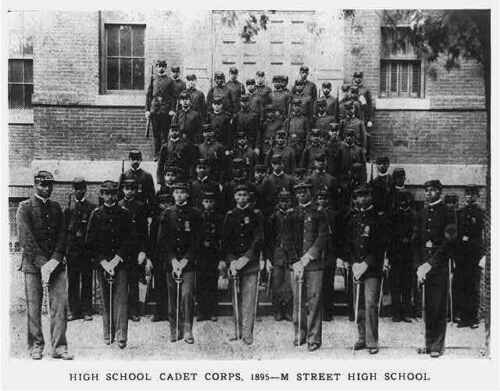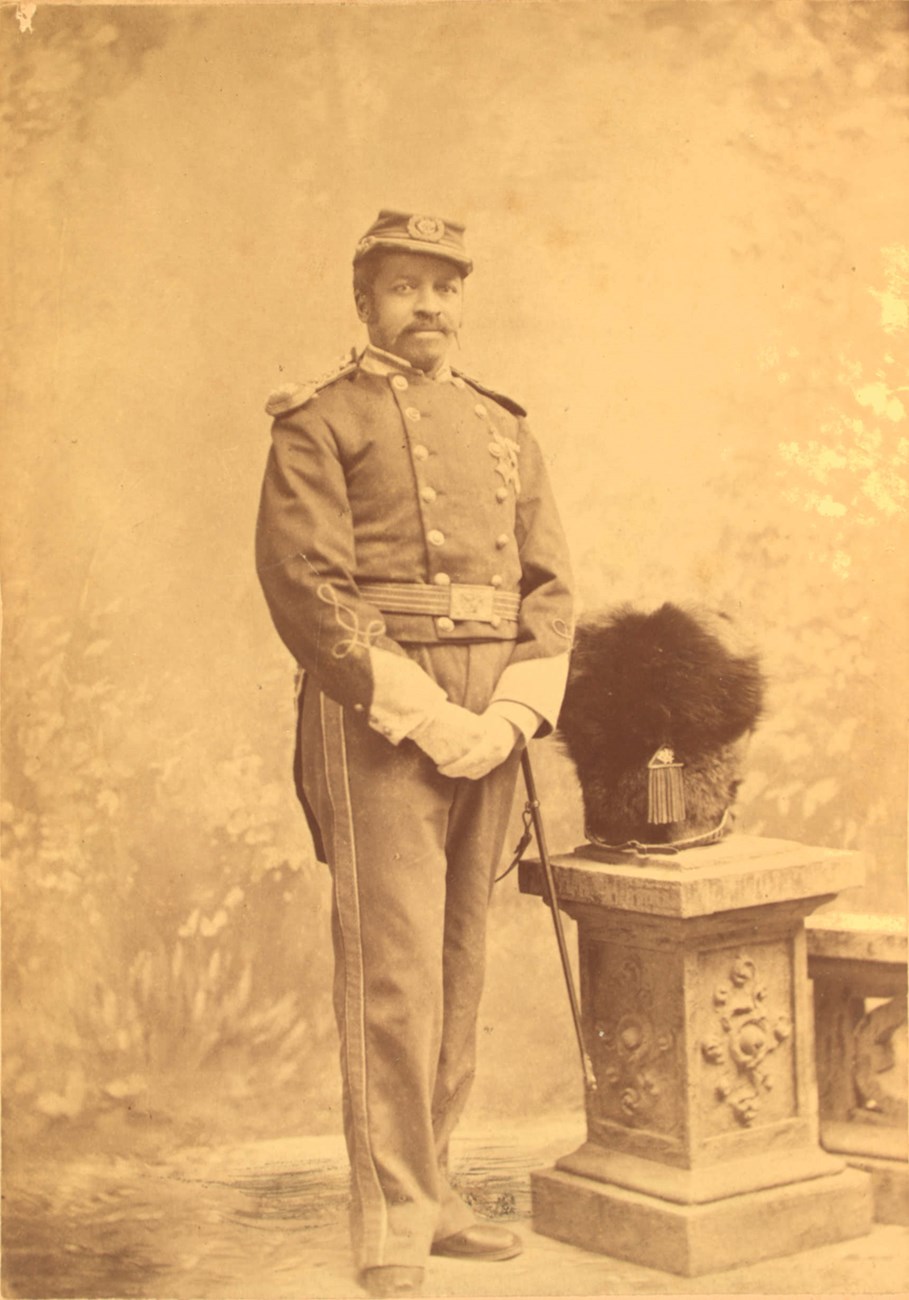Last updated: January 11, 2024
Article
DC Black Militias & The 1st Separate Battalion

Library of Congress, LC-USZ62-50704.
A Rich History of Black Militias
"You have given proof of the finest qualities of bravery, and by your daring exploits and your admirable scorn of danger, I recommend your regiment for a citation in the orders of the French Army." - General Mariano Goybet, Commander of the French 157th Division, addressing the men of the 372nd Infantry Regiment, 1918.[1]
“This unit was more than a focus of the social life of Black Washington, or a fraternal spirit which motivated so many militiamen: it was also a first-rate combat unit.” – Martin K. Gordon, writing about the 1st Separate Battalion, 1972.[2]
In 1867, Congress changed the laws surrounding militias to allow for the enrollment of African American men. Black men in the District of Columbia were quick to exercise their newly acquired rights and found their own militia companies.[3] On April 16, 1868, DC’s Butler Zouaves, Independent Blues, National Band, Georgetown Zouaves, and Liberty Guard were joined by four militia companies from Baltimore for a procession through the city marking DC's Emancipation Day.[4] These militiamen were regular staples of DC’s Emancipation celebrations throughout the 1800s – In 1872, when some ~300 militiamen (200 of them armed) paraded past the White House, they were saluted by President Ulysses Grant and his cabinet.[5] When the Emancipation Memorial was dedicated in Lincoln Park in 1876, three companies of the 1st Battalion Colored Troops escorted President Grant and featured speaker Frederick Douglass.[6]
In May 1887, two Black militia companies from Virginia and DC’s Washington Cadet Corps took part in the National Drill and Encampment, the nineteenth century’s only racially integrated militia competition.[7] The Washington Cadet Corps had been formed in 1880 by Civil War veteran and Medal of Honor recipient Christian A. Fleetwood, who commanded the militia from its inception until its 1891 incorporation into the District of Columbia’s National Guard.[8] These Black units did not win any competitions, but the Savannah Tribune reported that they carried themselves with “soldierly bearing” when two southern white militia units refused to participate in the parade through DC after being placed behind the Black units in the marching order. The editors of the Washington Bee suggested that the Memphis Zouaves and the Vicksburg Southrons fell out of formation because they “were jealous of the ringing cheers their Black rivals received.”[9]

Library of Congress, LC-USZ62-79812.

Library of Congress, LC-USZ62-48685.
African Americans in the DC National Guard: Discrimination and Determination
The DC National Guard first re-organized its independent militias in 1885, and ten of the Guard’s initial twenty-four regiments were African American units. Discriminatory treatment was a problem for these Black guardsmen from the very beginning. The officers of the guard’s white regiments were invited to the grand opening of the new Brigade Headquarters, but the officers of the Black regiments were not.[10] The Black regiments were regularly downsized, ostensibly for low membership, and in 1891, Commander Albert Ordway signaled his intent to disband the remaining African American regiments. The regiment was only saved when a group of prominent Black DC citizens appealed directly to President Benjamin Harrison, who ordered Ordway not to disband the Black units and to instead consolidate them into a single battalion – Thus, the 1st Separate Battalion was born.[11]
The intervention of prominent DC citizens saved the District’s Black militiamen from disbandment, but they would continue to endure racial discrimination. After Virginia’s Black militia units were disbanded in 1899, Governor James Hoge Tyler refused the request of DC militiamen to march in Warrenton, VA’s Emancipation Day procession.[12] Despite their routinely earning high scores in reviews and showing great enthusiasm to serve, DCNG Commander Brigadier General George H. Harries refused to accept any volunteers from the 1st Separate Battalion for active-duty service in the Spanish-American War of 1898.[13]
These hardships did not stop the men of the 1st Separate Battalion from taking a prominent place in their communities and remaining ready to serve. In 1909, they marched in parade at the dedication to the Dr. Benjamin Stephenson, Grand Army of the Republic Memorial, showcasing their skills to the Black Civil War veterans who paved the way for their military service.[14] The 1st Separate Battalion regularly cooperated with DC’s local Black Grand Army of the Republic posts – In 1909 and 1911, the Separate Battalion escorted the elderly Civil War veterans to Harmony National Cemetery to oversee the Memorial Day exercises.[15]
When the United States entered World War I in 1917, the 1st Separate Battalion was re-designated as the 1st Battalion, 372nd Infantry Regiment and sent to fight in France, where they “served with a distinction and bravery that rivaled the famed ‘Harlem Hellfighters.’”[16] They served for 6 months in France, fighting in the Champagne offensive and suffering more than 200 casualties. 19 enlisted men received individual decorations for valor, and the 372nd were collectively awarded the Croix de Guerre with Palm. [17] The legacy of the 1st Separate Battalion and DC’s Black militias that preceded it lives on today in the 372nd Military Police Battalion of the District of Columbia’s Army National Guard.

DC History Center.
Read about Black soldiers on the western frontier
Read about Black soldiers in the Spanish-American War
Read about Black soldiers in World War One
Read about African American Contributions to Memorial Day
Tags
- national mall and memorial parks
- black history
- african american history
- african american soldiers
- african american
- american military
- national guard
- militia
- militia men
- dc history
- dc
- washington dc
- segregation
- reconstruction
- reconstruction era
- telling all american stories
- history
- civil war to civil rights
- veterans
- ncr
- military
- civil rights
- african american veteran
